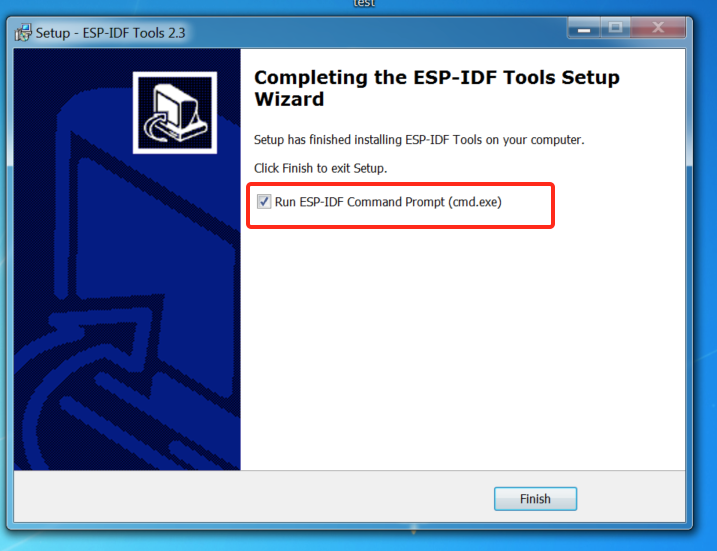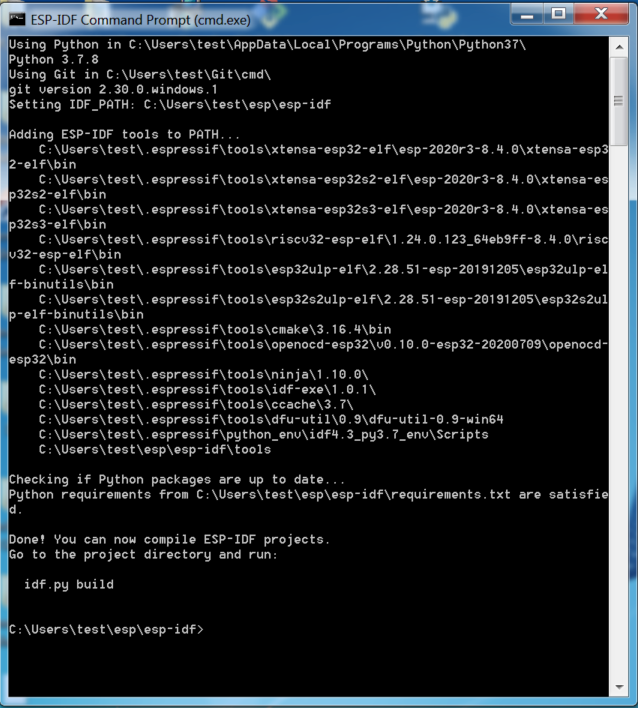Standard Setup of Toolchain for Windows¶
Introduction¶
ESP-IDF requires some prerequisite tools to be installed so you can build firmware for supported chips. The prerequisite tools include Python, Git, cross-compilers, CMake and Ninja build tools.
For this Getting Started we’re going to use the Command Prompt, but after ESP-IDF is installed you can use Eclipse or another graphical IDE with CMake support instead.
Note
Limitation: the installation path of Python or ESP-IDF must not contain white spaces or parentheses.
Limitation: the installation path of Python or ESP-IDF should not contain special characters (non-ASCII) unless the operating system is configured with “Unicode UTF-8” support. System Administrator can enable the support via Control Panel - Change date, time, or number formats - Administrative tab - Change system locale - check the option “Beta: Use Unicode UTF-8 for worldwide language support” - Ok and reboot the computer.
ESP-IDF Tools Installer¶
The easiest way to install ESP-IDF’s prerequisites is to download the ESP-IDF Tools installer from this URL:
https://dl.espressif.com/dl/esp-idf-tools-setup-2.4.exe
The installer includes the cross-compilers, OpenOCD, CMake and Ninja build tool. The installer can also download and run installers for Python 3.7 and Git For Windows if they are not already installed on the computer.
The installer also downloads one of the ESP-IDF release versions, or offers to use an existing one, if already present on your PC. If you don’t have one, please choose a directory for downloading ESP-IDF. The recommended directory is %userprofile%\esp where %userprofile% is your home directory. If you do not have it yet, please run the following command to create a new one:
mkdir %userprofile%\esp
At the end of installation, if you checkout Run ESP-IDF Command Prompt (cmd.exe), a new Windows Power Shell, i.e. the ESP-IDF Command Prompt will pop up.

Completing the ESP-IDF Tools Setup Wizard with Run ESP-IDF Command Prompt (cmd.exe)¶

ESP-IDF Command Prompt¶
Using the Command Prompt¶
For the remaining Getting Started steps, we’re going to use the Windows Command Prompt.
ESP-IDF Tools Installer also creates a shortcut in the Start menu to launch the ESP-IDF Command Prompt. This shortcut launches the Command Prompt (cmd.exe) and runs export.bat script to set up the environment variables (PATH, IDF_PATH and others). Inside this command prompt, all the installed tools are available.
Note that this shortcut is specific to the ESP-IDF directory selected in the ESP-IDF Tools Installer. If you have multiple ESP-IDF directories on the computer (for example, to work with different versions of ESP-IDF), you have two options to use them:
Create a copy of the shortcut created by the ESP-IDF Tools Installer, and change the working directory of the new shortcut to the ESP-IDF directory you wish to use.
Alternatively, run
cmd.exe, then change to the ESP-IDF directory you wish to use, and runexport.bat. Note that unlike the previous option, this way requires Python and Git to be present inPATH. If you get errors related to Python or Git not being found, use the first option.
Next Steps¶
If the ESP-IDF Tools Installer has finished successfully, then the development environment setup is complete. Proceed directly to Step 5. Start a Project.